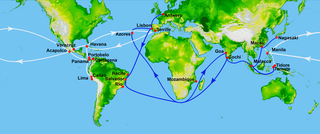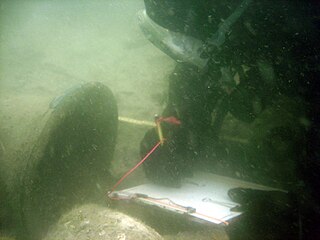Wrecking is the practice of taking valuables from a shipwreck which has foundered or run aground close to shore. Often an unregulated activity of opportunity in coastal communities, wrecking has been subjected to increasing regulation and evolved into what is now known as marine salvage.

Nuestra Señora de Atocha was a Spanish treasure galleon and the most widely known vessel of a fleet of ships that sank in a hurricane off the Florida Keys in 1622. At the time of her sinking, Nuestra Señora de Atocha was heavily laden with copper, silver, gold, tobacco, gems, and indigo from Spanish ports at Cartagena and Porto Bello in New Granada and Havana, bound for Spain. The Nuestra Señora de Atocha was named for the Basilica of Nuestra Señora de Atocha in Madrid, Spain. It was a heavily armed Spanish galleon that served as the almirante for the Spanish fleet. It would trail behind the other ships in the flotilla to prevent an attack from the rear.

The Spanish treasure fleet, or West Indies Fleet, was a convoy system of sea routes organized by the Spanish Empire from 1566 to 1790, which linked Spain with its territories in the Americas across the Atlantic. The convoys were general purpose cargo fleets used for transporting a wide variety of items, including agricultural goods, lumber, various metal resources such as silver and gold, gems, pearls, spices, sugar, tobacco, silk, and other exotic goods from the overseas territories of the Spanish Empire to the Spanish mainland. Spanish goods such as oil, wine, textiles, books and tools were transported in the opposite direction.

The maritime history of Florida describes significant past events relating to the U.S. state of Florida in areas concerning shipping, shipwrecks, and military installations and lighthouses constructed to protect or aid navigation and development of the Florida peninsula.
San Pedro Underwater Archaeological Preserve State Park is a Florida State Park located in 18 feet (5.5 m) of water, approximately 1.25 nautical miles (2.32 km) south of Indian Key. It became the second Florida Underwater Archaeological Preserve when it opened to the public in 1989. The heart of the park is the San Pedro, a submerged shipwreck from a 1733 Spanish flotilla, around which visitors can dive and snorkel. The San Pedro, a 287-ton Dutch-built vessel, and 21 other Spanish ships under the command of Rodrigo de Torres left Havana, Cuba, on Friday, July 13, 1733, bound for Spain. The San Pedro carried a cargo of 16,000 silver Mexican pesos and crates of Chinese porcelain. A hurricane struck the fleet, while entering the Straits of Florida, and sank or swamped most of the fleet. The wrecksite includes an "eighteenth century anchor, replica cannons, ballast stones encrusted with coral, a dedication plaque, and a mooring buoy system." The wreck was added to the U.S. National Register of Historic Places on May 31, 2001.
Urca de Lima is a Spanish shipwreck near Fort Pierce, Florida, United States. She was part of the 1715 Treasure Fleet, one of the numerous Spanish treasure fleets sailing between Spain and its colonies in the Americas. The wreck is located north of Fort Pierce Inlet, 200 yards off the shore from Jack Island Park. It became the first Florida Underwater Archaeological Preserve when dedicated in 1987. This was followed on May 31, 2001 with its addition to the U.S. National Register of Historic Places.
The San Jose Y Las Animas is a shipwreck with historical significance near Plantation Key, Florida, United States. It sank in a hurricane in 1733 and is located approximately 4 miles southeast of Plantation Key. On March 18, 1975, it was added to the U.S. National Register of Historic Places.

The 1715 Treasure Fleet was actually a combination of two Spanish treasure fleets returning from the New World to Spain, the "Nueva España Fleet", under Capt.-General Don Juan Esteban de Ubilla, and the "Tierra Firme Fleet", under Don Antonio de Echeverz y Zubiza. At two in the morning on Wednesday, July 31, 1715, seven days after departing from Havana, Cuba, all eleven ships of the fleet were lost in a hurricane along the east coast of Florida. A 12th ship, the French frigate "Le Grifon", had sailed with the fleet. Its captain was unfamiliar with the Florida coastline and elected to stay further out to sea. The "Grifon" safely returned to Europe.
The Florida Underwater Archaeological Preserves are a system of underwater parks in the state of Florida, US. They consist of shipwrecks of historic interest, both off the coast and inland, and are open all year round, free of charge. Similar programs have been created in California, Maryland, Michigan, New York, North Carolina, and Vermont.

Robert Forrest Burgess is an American author of non-fiction adventure books, as well as sport fishing and scuba diving magazine articles. His photographs illustrate his material.

George Robert Fischer was an American underwater archaeologist, considered the founding father of the field in the National Park Service. A native Californian, he did undergraduate and graduate work at Stanford University, and began his career with the National Park Service in 1959, which included assignments in six parks, the Washington, D.C. Office, and the Southeast Archaeological Center from which he retired in 1988. He began teaching courses in underwater archaeology at Florida State University in 1974 and co-instructed inter-disciplinary courses in scientific diving techniques. After retirement from the NPS his FSU activities were expanded and his assistance helped shape the university's program in underwater archaeology.

The McLarty Treasure Museum is located at 13180 North A1A on North Hutchinson Island, north of Windsor and Vero Beach, Florida, on the barrier island at the north end of Indian River County. The museum occupies part of the former site of the Survivors' and Salvagers' Camp - 1715 Fleet, and is part of Sebastian Inlet State Park. It houses exhibits on the history of the 1715 Spanish treasure fleet, and it features artifacts, displays, and an observation deck that overlooks the Atlantic Ocean. An A&E Network production, The Queen's Jewels and the 1715 Fleet, is shown, telling of the fleet's attempt to return to Spain when a hurricane struck off the Florida coast 300 years ago.

The Key West Shipwreck Museum is located in Key West, Florida, United States. It combines actors, films and actual artifacts to tell the story of 400 years of shipwreck salvage in the Florida Keys. The museum itself is a re-creation of a 19th-century warehouse built by wrecker tycoon Asa Tift. Many of the artifacts on display are from the 1985 rediscovery of the wrecked vessel Isaac Allerton, which sank in 1856 on the Florida Keys reef and turned out to be one the richest shipwrecks in Key West's history, having resulted in the Federal Wrecking Court's largest monetary award for the salvage of a single vessel.
This is a list of the 58 Multiple Property Submissions on the National Register of Historic Places in Florida. They contain approximately 400 individual listings of the more than 1,500 on the National Register for the state.

Charles T. Meide Jr., known as Chuck Meide, is an underwater and maritime archaeologist and currently the Director of LAMP, the research arm of the St. Augustine Lighthouse & Maritime Museum located in St. Augustine, Florida. Meide, of Syrian descent on his father's side, was born in Jacksonville, Florida, and raised in the adjacent coastal town of Atlantic Beach. He earned BA and MA degrees in Anthropology with a focus in underwater archaeology in 1993 and 2001 from Florida State University, where he studied under George R. Fischer, and undertook Ph.D. studies in Historical Archaeology at the College of William and Mary starting the following year. Meide has participated in a wide array of shipwreck and maritime archaeological projects across the U.S., especially in Florida, and throughout the Caribbean and Bermuda and in Australia and Ireland. From 1995 to 1997 he participated in the search for, discovery, and total excavation of La Salle's shipwreck, La Belle , lost in 1686. From December 1997 to January 1998 he served as Co-Director of the Kingstown Harbour Shipwreck Project, an investigation sponsored by the Institute of Maritime History and Florida State University into the wreck of the French frigate Junon (1778) lost in 1780 in St. Vincent and the Grenadines. In 1999 he directed the Dog Island Shipwreck Survey, a comprehensive maritime survey of the waters around a barrier island off the coast of Franklin County, Florida, and between 2004 and 2006 he directed the Achill Island Maritime Archaeology Project off the coast of County Mayo, Ireland. Since taking over as Director of LAMP in 2006, he has directed the First Coast Maritime Archaeology Project, a state-funded research and educational program focusing on shipwrecks and other maritime archaeological resources in the offshore and inland waters of Northeast Florida. In 2009, during this project, Meide discovered the "Storm Wreck," a ship from the final fleet to evacuate British troops and Loyalist refugees from Charleston at the end of the Revolutionary War, which wrecked trying to enter St. Augustine in late December 1782. He led the archaeological excavation of this shipwreck site each summer from 2010 through 2015, overseeing the recovery of thousands of well-preserved artifacts.

This is a timeline of the U.S. state of Florida.
Brent W. Brisben is an American treasure hunter best known for salvaging the shipwrecks of the historic 1715 Treasure Fleet, a Spanish treasure fleet returning from the New World to Spain. During the early morning hours of July 31, 1715, seven days after departing from Havana, Cuba, eleven of the twelve ships of this fleet were lost in a hurricane near present-day Vero Beach, Florida. Because the fleet was carrying silver, it is also known as the 1715 Plate Fleet. Some artifacts and even coins still wash up on Florida beaches from time to time.
The Douglass Beach Site is a marine inundated archaeological site on the eastern side of southern Florida. The site has two components; a cultural formation and a natural formation. The cultural formation aspect of the site is an 18th-century Spanish shipwreck, created when the 1715 century Spanish Plate Fleet ran aground near shore. Famed for their transport of gold and silver from the New World to Spain, the Spanish Plate Fleet site has been a destination for salvagers since the early 1960s. An archaic terrestrial site lies under the remains of the Spanish Plate Fleet and makes up the site's natural formation. Fossils of megafauna from the Pleistocene era have been uncovered here as well as some Native American artifacts. The terrestrial site's formation is believed to have been caused by years of sediment deposition and the slow accumulation of faunal remains caused by barrier island formation. The duality of this site makes it unique and an area of intrigue for archaeologists interested in exploring the factors influencing marine-inundated site preservation and the processes responsible marine-site formation.













